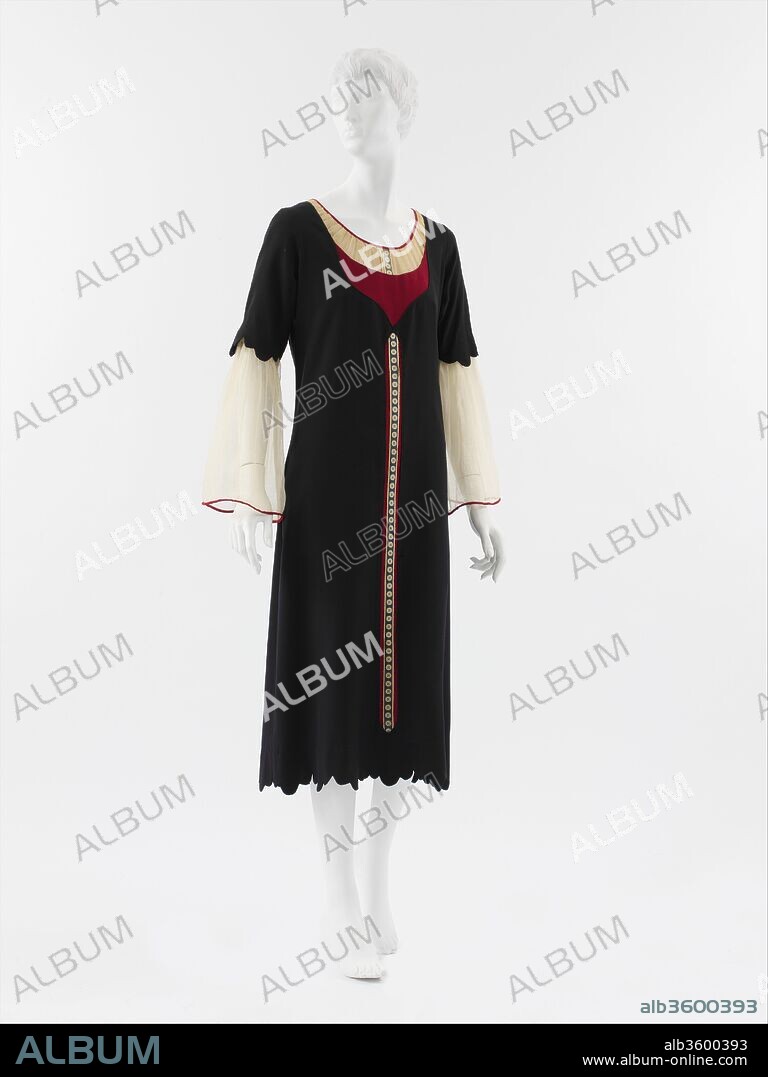alb3600393
PAUL POIRET. DRESS

|
Añadir a otro lightbox |
|
Añadir a otro lightbox |



¿Ya tienes cuenta? Iniciar sesión
¿No tienes cuenta? Regístrate
Compra esta imagen

Autor:
Título:
DRESS
Descripción:
Traducción automática: Vestir. Cultura: francés. Diseñador: Paul Poiret (francés, París París 1879-1944). Fecha: 1925. Debido a su atrevido colorido, ricos detalles, siluetas dramáticas (si bien simples) y referencias reconocibles de inmediato, los diseños de Poiret en el estilo orientalista llegaron a representar la identidad más fuerte de su casa. De hecho, las colecciones de Poiret fueron una amalgama de todos sus intereses. En lugar de un tema unificado, sus presentaciones ofrecieron a los clientes una variedad de siluetas y efectos estilísticos. Muchos diseños citaban ropa de hombre, ropa deportiva (algo que Poiret eventualmente rechazaría como un estilo inapropiado para la alta costura) y estilos históricos, especialmente los de la antigüedad, la Edad Media, el Renacimiento y el Segundo Imperio, en una mezcla ecléctica embriagadora. Aunque 'Bouclier' parece descartar otro período o cultura que podría haber sido su inspiración, el historicismo informado de Poiret se revela en el detalle trampantojo de la tapeta estrecha estampada con un motivo de botón, que hace referencia a los vestidos de delantal abotonados de la década de 1880. . El efecto es una ilusión de una blusa o camisola de algodón transparente debajo de un vestido rojo con un sobrevestido azul marino. Si bien sus características de diseño son principalmente frontales, Poiret agregó un lazo decorativo en el escote de la espalda, reforzando su espíritu lúdico. A través de su paleta de colores y su asociación con el estilo chic de las jóvenes parisinas, el vestido alude a la identidad nacional francesa. Fue representado en Art-Goût-Beauté con otro modelo llamado 'École', también en azul, blanco y rojo. Ambos vestidos se combinaron con accesorios a juego para subrayar sus matices nacionalistas. Poiret era un feroz patriota a pesar de haber sido criticado durante la Primera Guerra Mundial por su gusto boche debido a una caricatura en el periódico cómico alemán Simplicissimus que mostraba a un ama de casa alemana a la que su marido soldado le aseguraba que pronto conseguiría un nuevo vestido de Poiret. De hecho, para Poiret, el orientalismo y el clasicismo, a menudo vistos como modelos estéticos rivales en el discurso del modernismo, eran expresiones de su patriotismo que se reforzaban mutuamente, tan profundamente arraigadas estaban en la política cultural de Francia.
Dress. Culture: French. Designer: Paul Poiret (French, Paris 1879-1944 Paris). Date: 1925.
Because of their bold coloring, rich detailing, dramatic (if simple) silhouettes, and immediately recognizable references, designs by Poiret in the orientalist mode came to represent the strongest identity of his house. In fact, Poiret's collections were an amalgamation of all his interests. Rather than one unified theme, his presentations offered clients a range of silhouettes and stylistic effects. Many designs cited menswear, sportswear (something Poiret would eventually repudiate as an inappropriate style for the haute couture), and historical styles, especially those from antiquity, the Middle Ages, the Renaissance, and the Second Empire, in a heady eclectic mix.
Although 'Bouclier' appears to preclude another period or culture that might have been its inspiration, Poiret's informed historicism reveals itself in the trompe l'oeil detail of narrow placket printed with a button motif, which references the button-down pinafore dresses of the 1880s. The effect is of an illusion of a sheer cotton blouse or chemise under a red dress with a navy overdress. While its design features are primarily frontal, Poiret added a decorative bow to the back neckline, reinforcing its playful spirit.
Through its color palette and its association with the chic style of young Parisiennes, the dress alludes to French national identity. It was represented in Art-Goût-Beauté with another model called 'École,' also rendered in blue, white, and red. Both dresses were paired with matching accessories to underscore their nationalistic overtones. Poiret was a fierce patriot despite having been criticized during World War I for his boche taste because of a cartoon in the German comic paper Simplicissimus that featured a German housewife being assured by her soldier husband that she would soon get a new Poiret dress. Indeed, for Poiret, orientalism and classicism, often seen as rival aesthetic models in the discourse of modernism, were mutually reinforcing expressions of his patriotism, so deep-rooted were they in the cultural politics of France.
Técnica/material:
wool, silk
Museo:
Metropolitan Museum of Art, New York, USA
Crédito:
Album / Metropolitan Museum of Art, NY
Autorizaciones:
Modelo: No - Propiedad: No
¿Preguntas relacionadas con los derechos?
¿Preguntas relacionadas con los derechos?
Tamaño imagen:
3170 x 4226 px | 38.3 MB
Tamaño impresión:
26.8 x 35.8 cm | 10.6 x 14.1 in (300 dpi)
Palabras clave:
 Pinterest
Pinterest Twitter
Twitter Facebook
Facebook Copiar enlace
Copiar enlace Email
Email
